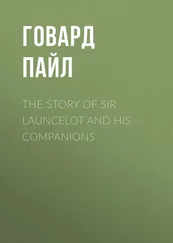Jessie Weston - The Legend of Sir Lancelot du Lac
Здесь есть возможность читать онлайн «Jessie Weston - The Legend of Sir Lancelot du Lac» — ознакомительный отрывок электронной книги совершенно бесплатно, а после прочтения отрывка купить полную версию. В некоторых случаях можно слушать аудио, скачать через торрент в формате fb2 и присутствует краткое содержание. Жанр: foreign_prose, foreign_antique, на английском языке. Описание произведения, (предисловие) а так же отзывы посетителей доступны на портале библиотеки ЛибКат.
- Название:The Legend of Sir Lancelot du Lac
- Автор:
- Жанр:
- Год:неизвестен
- ISBN:нет данных
- Рейтинг книги:5 / 5. Голосов: 1
-
Избранное:Добавить в избранное
- Отзывы:
-
Ваша оценка:
- 100
- 1
- 2
- 3
- 4
- 5
The Legend of Sir Lancelot du Lac: краткое содержание, описание и аннотация
Предлагаем к чтению аннотацию, описание, краткое содержание или предисловие (зависит от того, что написал сам автор книги «The Legend of Sir Lancelot du Lac»). Если вы не нашли необходимую информацию о книге — напишите в комментариях, мы постараемся отыскать её.
The Legend of Sir Lancelot du Lac — читать онлайн ознакомительный отрывок
Ниже представлен текст книги, разбитый по страницам. Система сохранения места последней прочитанной страницы, позволяет с удобством читать онлайн бесплатно книгу «The Legend of Sir Lancelot du Lac», без необходимости каждый раз заново искать на чём Вы остановились. Поставьте закладку, и сможете в любой момент перейти на страницу, на которой закончили чтение.
Интервал:
Закладка:
Dating apparently from the same period, the middle of the twelfth century, is a bas-relief of the cathedral of Modena, representing a female figure standing on the summit of a tower, towards which several armed knights are approaching. Each knight is named, and we find represented Arthur himself, Gawain, Kay, Ider, Carados, and a certain Galuariun, who has not been identified. Lancelot is not among them. 2 2 Described and illustrated by Zimmerman in Oberitalische Plastik im frühen und hohen Mittelalter : Leipzig, 1897. Cf. also Romania , xxvii. p. 510.
The Welsh Arthurian stories again know nothing of Lancelot, though certain of them contain long lists of heroes of Arthur's court. 3 3 It is difficult to resist the conclusion that if the Welsh stories were as late in date and as dependent upon French tradition as some scholars maintain, Lancelot would certainly be mentioned in them.
So far as we can at present tell, the earliest mention of the knight is that contained in the Erec of Chrétien de Troyes, where in a long list of the heroes of the Round Table, ranged according to merit (at least in the case of the earlier names), Lanceloz del Lac is reckoned third, the first two being Gawain and Erec. 4 4 Cf. Erec , Foerster's ed., l. 1694; Hartmann's Erec , l. 1630.
In the German version by Hartmann von Aue, he occupies the same place, but is called Lanzelot von Arlac. Nothing more is related of him: he plays no rôle in the story, he is a name, and nought else. In a later poem by Chrétien, Cligés , the same position, third on the roll of heroes, is ascribed to Lancelot, but here it is Perceval, and not Erec, who ranks second. The hero of the poem, Cligés, appears at a tournament four successive days, in different armour, and overthrows Segramor, Lancelot, and Perceval, finally fighting an undecided combat with Gawain. 5 5 Cligés , Foerster's ed., ll. 4765-4798.
The Cligés reference is particularly noticeable, as the motif of the story is the love of the hero for the young wife of his uncle and sovereign. In this connection the loves of Tristan and Iseult are often referred to, but Lancelot and Guinevere never. It seems clear that when Chrétien wrote this poem he did not know Lancelot as the lover of Arthur's queen and the chief of Arthur's knights.
But in the poem which followed the Cligés , Le Chevalier de la Charrette , Lancelot suddenly appears in both these characters, Gawain's superior and the lover of Guinevere: no explanation of the changed position is offered, but Chrétien takes for granted the familiarity of his audience with the relations between the knight and the queen. To add to the confusion, in the succeeding poem Le Chevalier au Lion , Lancelot is only once referred to, in connection with the Charrette adventure, and is never mentioned as one of the knights of Arthurs household; while in Chrétien's last poem, the Perceval , he is altogether ignored. 6 6 The advocates of Chrétien as an independent and original genius would do well carefully to consider the meaning of such curious inconsistency. If Chrétien were dealing with matter either of his own invention, or of his own free adaptation, he would surely have been more careful of the unities. If, on the other hand, he simply retold tales belonging to different stages of Arthurian tradition, this is exactly what we might expect to find.
It is very difficult, indeed impossible, to date Chrétien's poems with exactness. The only two which afford clear internal evidence on the point, Le Chevalier de la Charrette and Le Chevalier au Lion , fall within the years 1164-1173. Erec was the first of his Arthurian poems, and between Erec and the Charrette , certainly one work, Cligés , and it may be several, intervened. 7 7 In the opening lines of Cligés , Chrétien gives a list of his works. This includes a version of the story of Tristan , and several translations from Ovid. Tristan probably preceded Erec , but there is nothing to indicate the relative order of the other works.
Very probably the Erec was written early in the decade, 1150-60, and taken in conjunction with the negative evidence afforded by the Brut and the Italian bas-relief, it goes to prove that whereas the name of Gawain, as connected with Arthur, was known by the end of the eleventh century, 8 8 Signor Rajna has found the names of Arthur and Gawain in Italian deeds of the first quarter of the twelfth century, and from the nature of some of these deeds it is clear that the persons named therein cannot have been born later than 1080.
Arthurian tradition knew nothing of Lancelot till the latter half of the twelfth; and that no mention of his relations with Guinevere is found till between 1160-1170, that is, a decade after the first mention of his name. It is, of course, a well-recognised fact in the study of romance, that the date of a manuscript does not fix the date of the story contained in it; a younger manuscript may contain the same story under an older form. As a rule, the versions contained in Chrétien's poems appear to present a fairly old form of the stories they relate, saving in the case of Lancelot. About this knight, Chrétien either knows nothing or he knows too much. The earlier stages of his story he leaves unrecorded; yet an allusion in the Charrette poem 9 9 Charrette , ll. 2347-2362.
shows that he was not unacquainted with the legend concerning his youth and upbringing. Two versions of this legend have been preserved to us, one in verse and one in prose. In the following chapter we will examine the older of these versions, and inquire into the origin of our hero's name.
CHAPTER II
The origin of the name Lancelot has been a subject of considerable debate among scholars, and has given rise to the most widely differing explanations. M. de la Villemarqué, who was a warm advocate of the Welsh origin of the Arthurian stories, derived the name from the French l'ancelot , a youth or servant, which he held to be a translation of the Welsh Melwas, or Maelwas. This solution was rejected by M. Gaston Paris, in his study on the Lancelot poems, 10 10 Romania , vol. x. p. 492.
in which he showed that ancelot was not a French common name, and that Maelwas did not bear the signification attributed to it. Professor Rhys, 11 11 Studies in the Arthurian Legend , chap. vi.
adopting the theory of the Welsh origin of the name, which in its present form he admitted only exists in Welsh literature as borrowed from French or English sources, decided that it represented a Welsh variant of Peredur, the root of this latter name being Pâr = a spear or lance . 'The characters,' says Professor Rhys, 'were originally the same, though their respective developments eventually differed very widely.' I doubt if this solution ever found any adherents except its author: it is sufficient to remark that the derivation of Peredur, on which it rests, is by no means universally accepted, and that Lancelot is in no special way connected with a spear or lance. 12 12 The only adventure of the kind I can recall is that of the fiery lance of the Charrette and prose Lancelot , an adventure which is the common property of several knights, and by no means confined to Lancelot.
It is certainly true that the Lancelot story shows signs of having been affected by the Perceval legend, but as we shall see the borrowings are restricted to one special and purely continental form of the story.
M. Gaston Paris, in the study referred to above, suggested that Lancelot might be either a Celtic name altered, or, more probably, the substitution, by French poets, of a name of Germanic origin for one of Breton form strange to the ears of their French audiences, e.g. it might be a diminutive form of Lanzo . This is also the conclusion of Professor Zimmer. 13 13 Zeitschrift für französische Sprache und Litteratur , vol. xii. Heft I.
The prefix Lant is often found in names of Frankish origin transferred to Breton ground: such names are Lando, Landolin; Lanzo, Lanzolin, etc.
Интервал:
Закладка:
Похожие книги на «The Legend of Sir Lancelot du Lac»
Представляем Вашему вниманию похожие книги на «The Legend of Sir Lancelot du Lac» списком для выбора. Мы отобрали схожую по названию и смыслу литературу в надежде предоставить читателям больше вариантов отыскать новые, интересные, ещё непрочитанные произведения.
Обсуждение, отзывы о книге «The Legend of Sir Lancelot du Lac» и просто собственные мнения читателей. Оставьте ваши комментарии, напишите, что Вы думаете о произведении, его смысле или главных героях. Укажите что конкретно понравилось, а что нет, и почему Вы так считаете.












